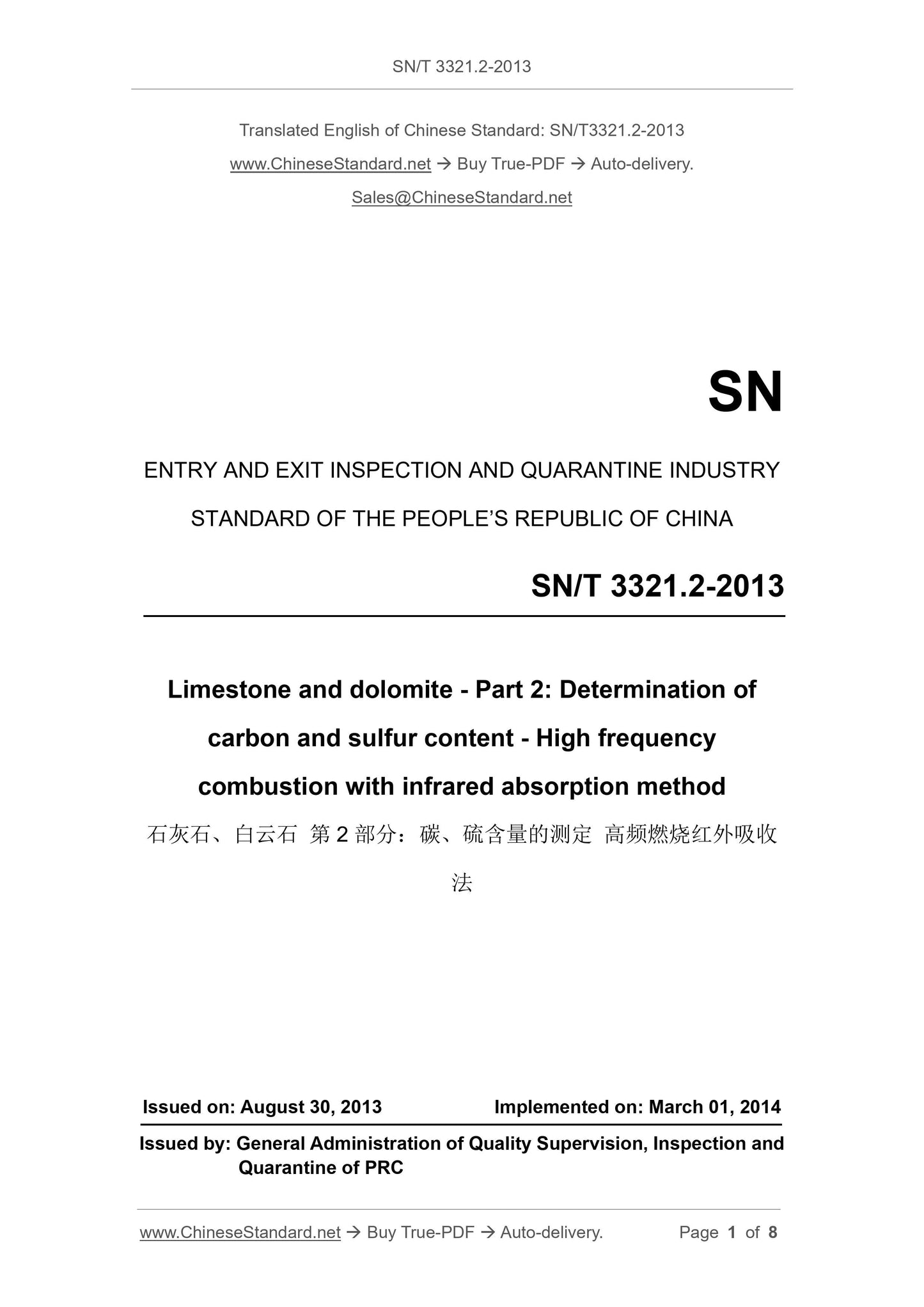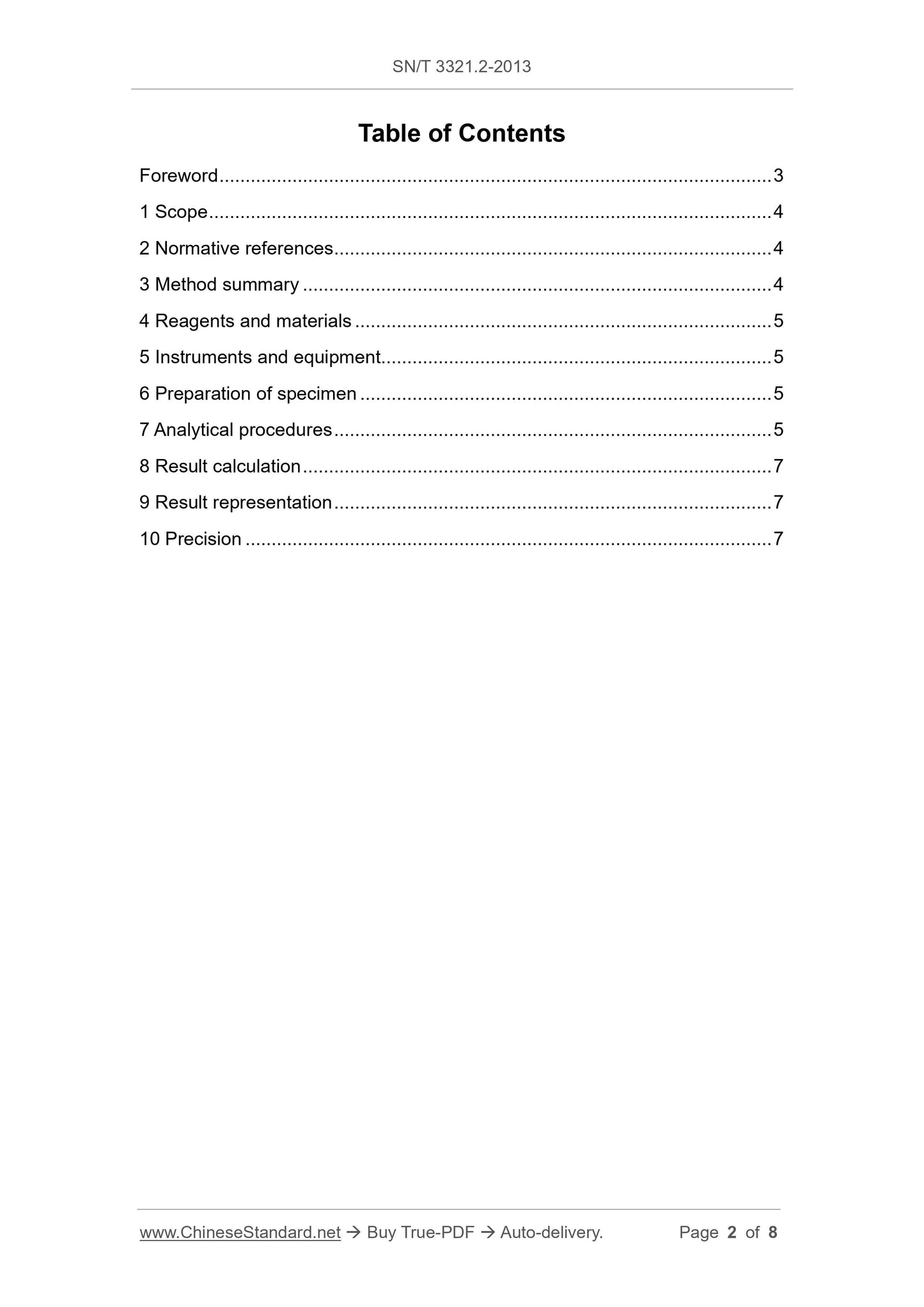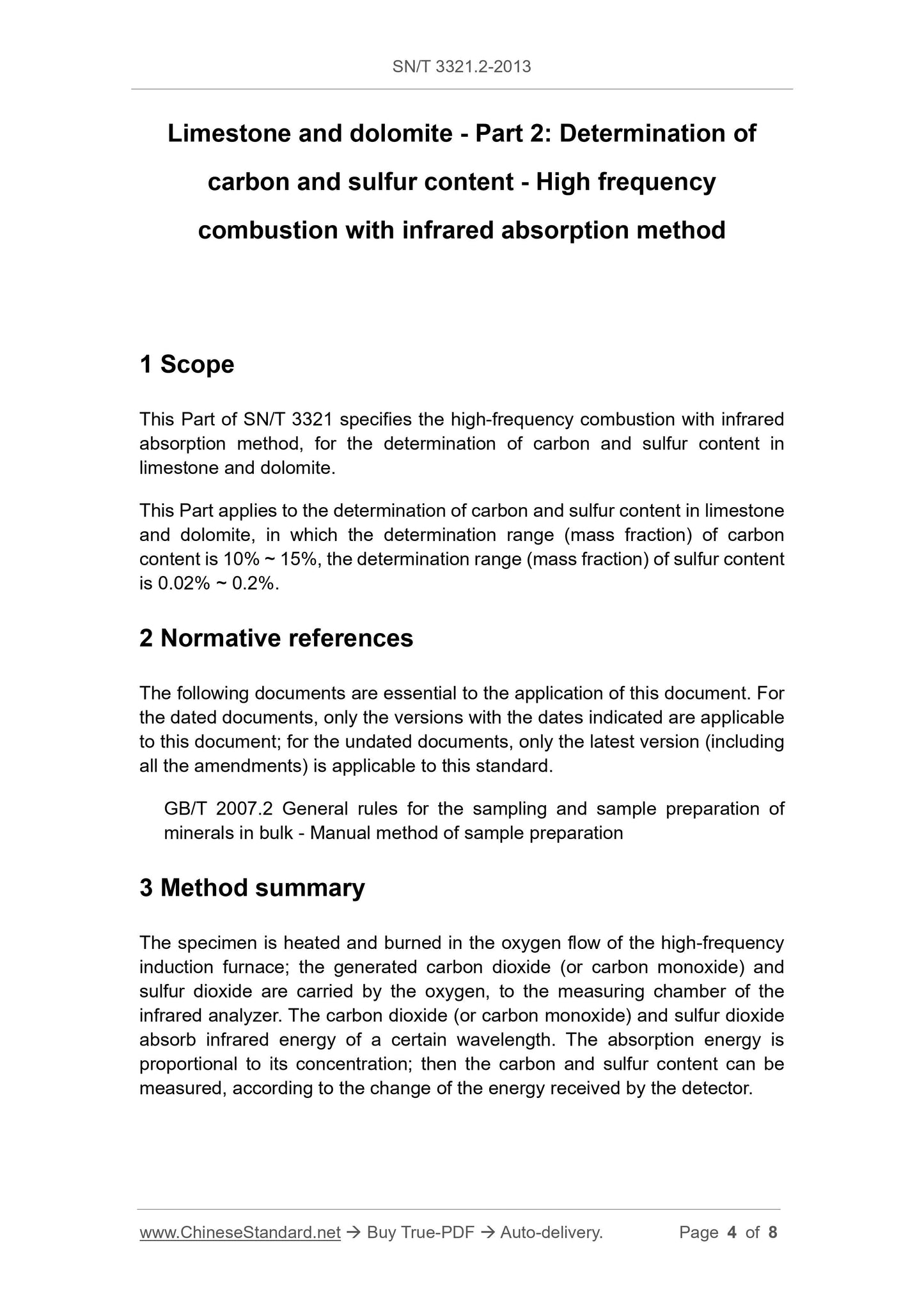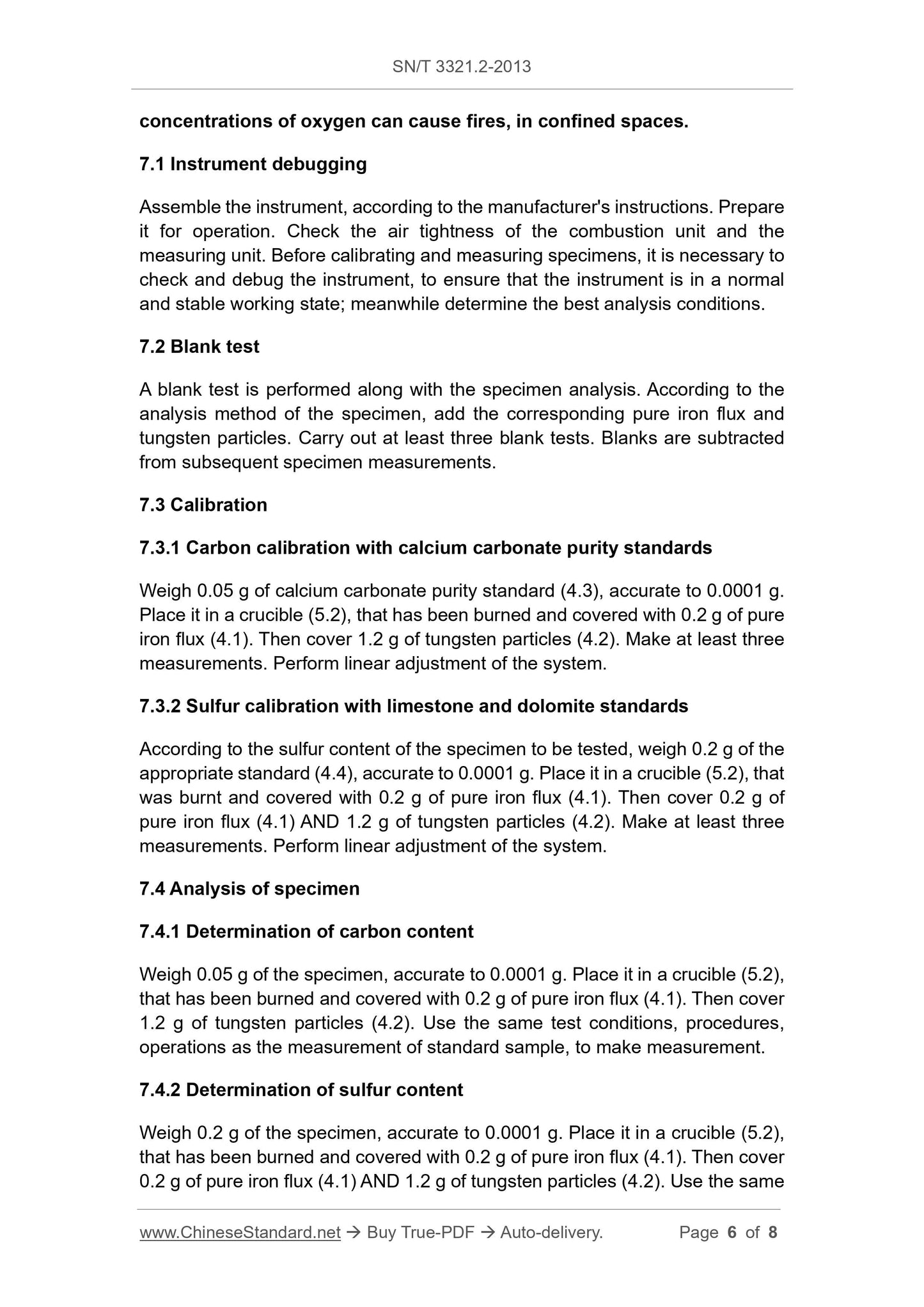1
/
από
4
PayPal, credit cards. Download editable-PDF and invoice in 1 second!
SN/T 3321.2-2013 English PDF (SNT3321.2-2013)
SN/T 3321.2-2013 English PDF (SNT3321.2-2013)
Κανονική τιμή
$140.00 USD
Κανονική τιμή
Τιμή έκπτωσης
$140.00 USD
Τιμή μονάδας
/
ανά
Τα έξοδα αποστολής υπολογίζονται κατά την ολοκλήρωση της αγοράς.
Δεν ήταν δυνατή η φόρτωση της διαθεσιμότητας παραλαβής
Delivery: 3 seconds. Download true-PDF + Invoice.
Get QUOTATION in 1-minute: Click SN/T 3321.2-2013
Historical versions: SN/T 3321.2-2013
Preview True-PDF (Reload/Scroll if blank)
SN/T 3321.2-2013: Limestone and dolomite. Part 2: Determination of carbon and sulfur content. High frequency combustion with infrared absorption method
SN/T 3321.2-2013
SN
ENTRY AND EXIT INSPECTION AND QUARANTINE INDUSTRY
STANDARD OF THE PEOPLE’S REPUBLIC OF CHINA
Limestone and dolomite - Part 2: Determination of
carbon and sulfur content - High frequency
combustion with infrared absorption method
ISSUED ON: AUGUST 30, 2013
IMPLEMENTED ON: MARCH 01, 2014
Issued by: General Administration of Quality Supervision, Inspection and
Quarantine of PRC
Table of Contents
Foreword ... 3
1 Scope ... 4
2 Normative references ... 4
3 Method summary ... 4
4 Reagents and materials ... 5
5 Instruments and equipment... 5
6 Preparation of specimen ... 5
7 Analytical procedures ... 5
8 Result calculation ... 7
9 Result representation ... 7
10 Precision ... 7
Limestone and dolomite - Part 2: Determination of
carbon and sulfur content - High frequency
combustion with infrared absorption method
1 Scope
This Part of SN/T 3321 specifies the high-frequency combustion with infrared
absorption method, for the determination of carbon and sulfur content in
limestone and dolomite.
This Part applies to the determination of carbon and sulfur content in limestone
and dolomite, in which the determination range (mass fraction) of carbon
content is 10% ~ 15%, the determination range (mass fraction) of sulfur content
is 0.02% ~ 0.2%.
2 Normative references
The following documents are essential to the application of this document. For
the dated documents, only the versions with the dates indicated are applicable
to this document; for the undated documents, only the latest version (including
all the amendments) is applicable to this standard.
GB/T 2007.2 General rules for the sampling and sample preparation of
minerals in bulk - Manual method of sample preparation
3 Method summary
The specimen is heated and burned in the oxygen flow of the high-frequency
induction furnace; the generated carbon dioxide (or carbon monoxide) and
sulfur dioxide are carried by the oxygen, to the measuring chamber of the
infrared analyzer. The carbon dioxide (or carbon monoxide) and sulfur dioxide
absorb infrared energy of a certain wavelength. The absorption energy is
proportional to its concentration; then the carbon and sulfur content can be
measured, according to the change of the energy received by the detector.
concentrations of oxygen can cause fires, in confined spaces.
7.1 Instrument debugging
Assemble the instrument, according to the manufacturer's instructions. Prepare
it for operation. Check the air tightness of the combustion unit and the
measuring unit. Before calibrating and measuring specimens, it is necessary to
check and debug the instrument, to ensure that the instrument is in a normal
and stable working state; meanwhile determine the best analysis conditions.
7.2 Blank test
A blank test is performed along with the specimen analysis. According to the
analysis method of the specimen, add the corresponding pure iron flux and
tungsten particles. Carry out at least three blank tests. Blanks are subtracted
from subsequent specimen measurements.
7.3 Calibration
7.3.1 Carbon calibration with calcium carbonate purity standards
Weigh 0.05 g of calcium carbonate purity standard (4.3), accurate to 0.0001 g.
Place it in a crucible (5.2), that has been burned and covered with 0.2 g of pure
iron flux (4.1). Then cover 1.2 g of tungsten particles (4.2). Make at least three
measurements. Perform linear adjustment of the system.
7.3.2 Sulfur calibration with limestone and dolomite standards
According to the sulfur content of the specimen to be tested, weigh 0.2 g of the
appropriate standard (4.4), accurate to 0.0001 g. Place it in a crucible (5.2), that
was burnt and covered with 0.2 g of pure iron flux (4.1). Then cover 0.2 g of
pure iron flux (4.1) AND 1.2 g of tungsten particles (4.2). Make at least three
measurements. Perform linear adjustment of the system.
7.4 Analysis of specimen
7.4.1 Determination of carbon content
Weigh 0.05 g of the specimen, accurate to 0.0001 g. Place it in a crucible (5.2),
that has been burned and covered with 0.2 g of pure iron flux (4.1). Then cover
1.2 g of tungsten particles (4.2). Use the same test conditions, procedures,
operations as the measurement of standard sample, to make measurement.
7.4.2 Determination of sulfur content
Weigh 0.2 g of the specimen, accurate to 0.0001 g. Place it in a crucible (5.2),
that has been burned and covered with 0.2 g of pure iron flux (4.1). Then cover
0.2 g of pure iron flux (4.1) AND 1.2 g of tungsten particles (4.2). Use the same
Get QUOTATION in 1-minute: Click SN/T 3321.2-2013
Historical versions: SN/T 3321.2-2013
Preview True-PDF (Reload/Scroll if blank)
SN/T 3321.2-2013: Limestone and dolomite. Part 2: Determination of carbon and sulfur content. High frequency combustion with infrared absorption method
SN/T 3321.2-2013
SN
ENTRY AND EXIT INSPECTION AND QUARANTINE INDUSTRY
STANDARD OF THE PEOPLE’S REPUBLIC OF CHINA
Limestone and dolomite - Part 2: Determination of
carbon and sulfur content - High frequency
combustion with infrared absorption method
ISSUED ON: AUGUST 30, 2013
IMPLEMENTED ON: MARCH 01, 2014
Issued by: General Administration of Quality Supervision, Inspection and
Quarantine of PRC
Table of Contents
Foreword ... 3
1 Scope ... 4
2 Normative references ... 4
3 Method summary ... 4
4 Reagents and materials ... 5
5 Instruments and equipment... 5
6 Preparation of specimen ... 5
7 Analytical procedures ... 5
8 Result calculation ... 7
9 Result representation ... 7
10 Precision ... 7
Limestone and dolomite - Part 2: Determination of
carbon and sulfur content - High frequency
combustion with infrared absorption method
1 Scope
This Part of SN/T 3321 specifies the high-frequency combustion with infrared
absorption method, for the determination of carbon and sulfur content in
limestone and dolomite.
This Part applies to the determination of carbon and sulfur content in limestone
and dolomite, in which the determination range (mass fraction) of carbon
content is 10% ~ 15%, the determination range (mass fraction) of sulfur content
is 0.02% ~ 0.2%.
2 Normative references
The following documents are essential to the application of this document. For
the dated documents, only the versions with the dates indicated are applicable
to this document; for the undated documents, only the latest version (including
all the amendments) is applicable to this standard.
GB/T 2007.2 General rules for the sampling and sample preparation of
minerals in bulk - Manual method of sample preparation
3 Method summary
The specimen is heated and burned in the oxygen flow of the high-frequency
induction furnace; the generated carbon dioxide (or carbon monoxide) and
sulfur dioxide are carried by the oxygen, to the measuring chamber of the
infrared analyzer. The carbon dioxide (or carbon monoxide) and sulfur dioxide
absorb infrared energy of a certain wavelength. The absorption energy is
proportional to its concentration; then the carbon and sulfur content can be
measured, according to the change of the energy received by the detector.
concentrations of oxygen can cause fires, in confined spaces.
7.1 Instrument debugging
Assemble the instrument, according to the manufacturer's instructions. Prepare
it for operation. Check the air tightness of the combustion unit and the
measuring unit. Before calibrating and measuring specimens, it is necessary to
check and debug the instrument, to ensure that the instrument is in a normal
and stable working state; meanwhile determine the best analysis conditions.
7.2 Blank test
A blank test is performed along with the specimen analysis. According to the
analysis method of the specimen, add the corresponding pure iron flux and
tungsten particles. Carry out at least three blank tests. Blanks are subtracted
from subsequent specimen measurements.
7.3 Calibration
7.3.1 Carbon calibration with calcium carbonate purity standards
Weigh 0.05 g of calcium carbonate purity standard (4.3), accurate to 0.0001 g.
Place it in a crucible (5.2), that has been burned and covered with 0.2 g of pure
iron flux (4.1). Then cover 1.2 g of tungsten particles (4.2). Make at least three
measurements. Perform linear adjustment of the system.
7.3.2 Sulfur calibration with limestone and dolomite standards
According to the sulfur content of the specimen to be tested, weigh 0.2 g of the
appropriate standard (4.4), accurate to 0.0001 g. Place it in a crucible (5.2), that
was burnt and covered with 0.2 g of pure iron flux (4.1). Then cover 0.2 g of
pure iron flux (4.1) AND 1.2 g of tungsten particles (4.2). Make at least three
measurements. Perform linear adjustment of the system.
7.4 Analysis of specimen
7.4.1 Determination of carbon content
Weigh 0.05 g of the specimen, accurate to 0.0001 g. Place it in a crucible (5.2),
that has been burned and covered with 0.2 g of pure iron flux (4.1). Then cover
1.2 g of tungsten particles (4.2). Use the same test conditions, procedures,
operations as the measurement of standard sample, to make measurement.
7.4.2 Determination of sulfur content
Weigh 0.2 g of the specimen, accurate to 0.0001 g. Place it in a crucible (5.2),
that has been burned and covered with 0.2 g of pure iron flux (4.1). Then cover
0.2 g of pure iron flux (4.1) AND 1.2 g of tungsten particles (4.2). Use the same
Share








